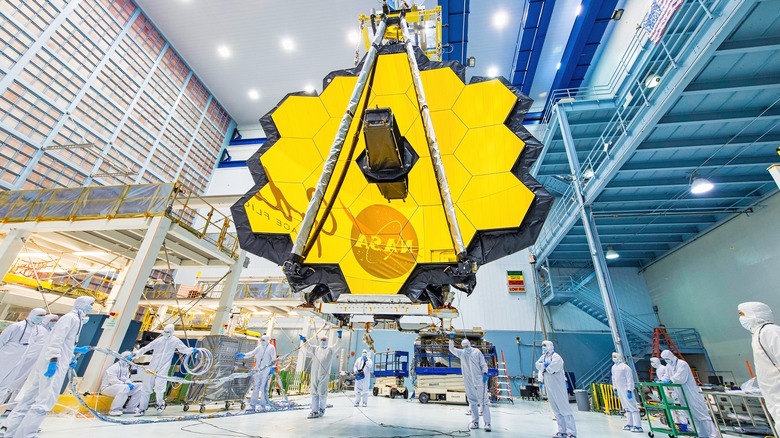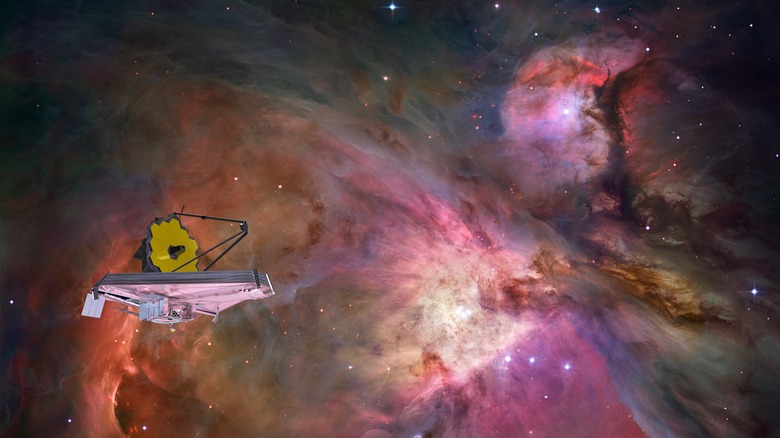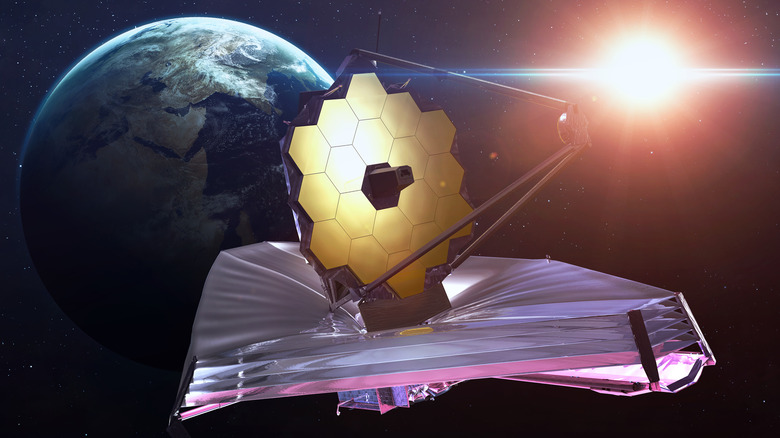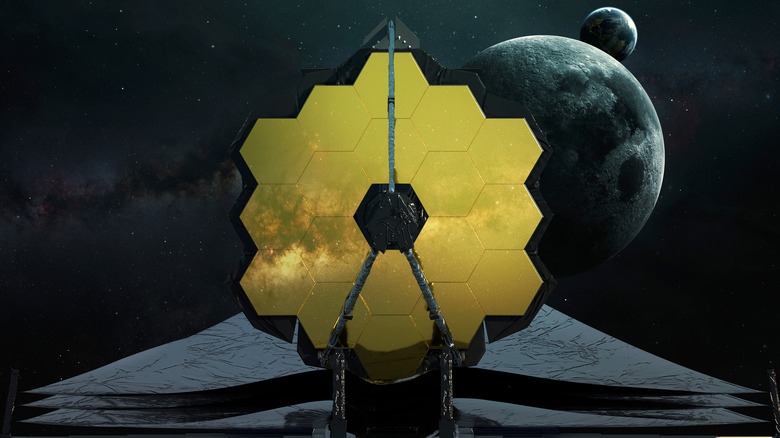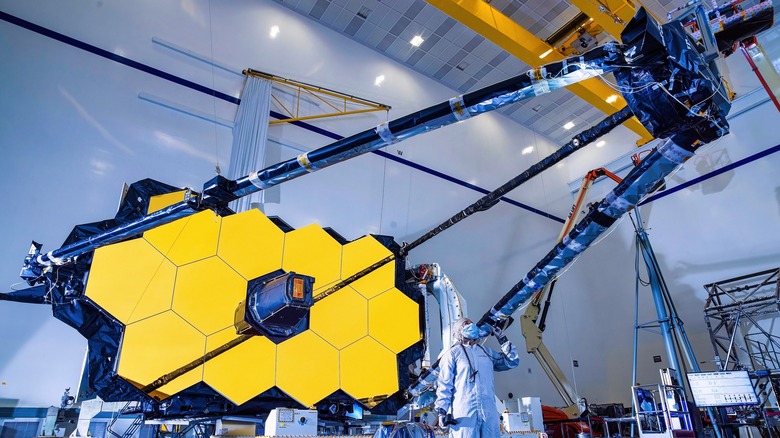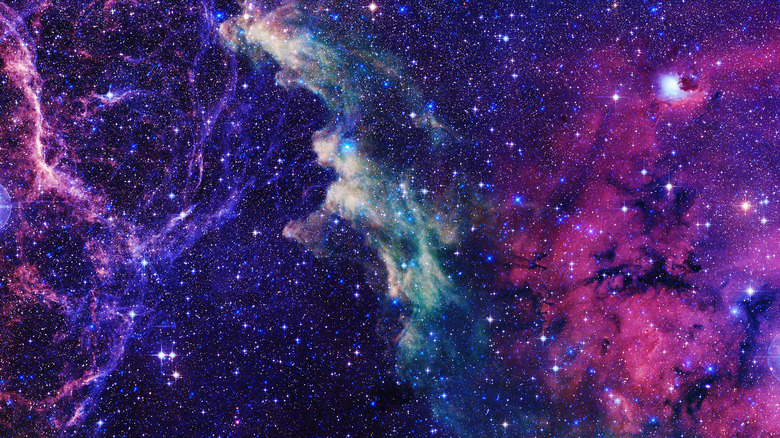The Revolutionary James Webb Space Telescope Explained
Fourteen countries, 29 U.S. states, 30 years, $10 billion, hundreds of human minds, and numerous international agencies including the European Space Agency (ESA), Canadian Space Agency (CSA), Northrup Grumman (an industrial engineering contractor) to build physical components, and much, much more: This is what it's taken to bring the James Webb Space Telescope (JWST) to life. JWST really is the single most advanced marvel of engineering ever produced by human hands. We say this without hyperbole or hype, just as a factual statement. Sorry, Pyramids at Giza lovers.
JWST was launched on Christmas Day 2021, as the BBC overviews. Too big to rocket to space in its final, sky-eyeing form, it was sent off folded like origami. It doesn't look like a tube with a monocle you stick up to your eye in your backyard. It doesn't look like anything you'd imagine a "telescope" to be. One side is a giant, hexagonal, beryllium light-collector composed of 18 smaller hexes. This is the telescope's "dark" side. The other side is five layers of solar shields that always face the sun — it's "light side." The shields charge the telescope and also protect the light collectors on the dark side, so they can peer into space like a moviegoer in a dimly lit theater.
The entire, mobile, stellar observatory (because that's what it really is) was sent into space and unfolded remotely, piece by piece. It's set to revolutionize our understanding of this vast void we call home for a decade to come.
Gazing through time toward the Big Bang
In the words of Dr. John Mather (on SmarterEveryDay via YouTube), Nobel Prize-winning scientist and the James Webb Space Telescope's original senior project scientist, JWST will allow us to see the universe's very first stars and galaxies, first black holes, images related to how stars and black holes form, how solar systems work, exoplanets (planets around other suns), what makes Earth special (if at all), evidence of now-only-theoretical objects and phenomena, and much more. Some have suggested that JWST could even, essentially, "see" the Big Bang itself.
How in the world can JWST do this? As Webb Telescope overviews, JWST drills down into infrared light of wavelengths 0.6 to 28 microns long. Because the universe continues to expand, light heading away from Earth appears to stretch out. This is similar to the Doppler Effect, where a passing siren sounds lower as it moves away. By checking how much light has "red shifted," we can look further and further into the past. Different chemicals produce different wavelengths (like green vs. orange colors, for instance), and this is how we know if light is produced by hydrogen, helium, etc. Stunningly enough, JWST will even allow us to basically look through objects, such as gas clouds. Longer wavelengths like infrared bounce less, and more or less pass through shorter-waved light.
In this way, as Royal Museums Greenwich shows, JWST complements the Hubble Space Telescope's focus on ultraviolet and visible light.
Shields in the sun, mirrors in the dark
The James Webb Space Telescope's engineering is truly, truly bonkers. As NASA explains, the big, hexagonal light collectors on its dark side are designed to produce as massive of a picture as possible. Light bounces off of them into a second, much smaller mirror placed face-to-face with the big one. That mirror reflects the light into an aperture inside the main body of the telescope (the "instrument package"), which sends the light to a fourth, "fine steering" mirror that adjusts for the telescope's motion. The entire mirror apparatus is referred to as a "three-mirror anastigmatic" telescope, because it corrects for the telescope's "astigmatism," exactly like lens-based imperfections in the human eye.
JWST's main body protrudes into the telescope's light side facing the sun. It contains all the camera sensors, electronics, power supplies, fuel tanks, transmitters, receivers, and computers necessary for the entire telescope to function.
JWST also uses rocket jets to maintain its orbit and things called "reaction wheels" to adjust its orientation, via Universe Today. Bit by bit, pressure from sunlight (solar radiation) will muck up JWST's orientation in space. So, JWST has a built-in chassis of little wheels that rotate to control the telescope's angular momentum. The spinning wheels regulate the orientation of the telescope at all times, similar to how a motorcyclist will speed up or brake in midair to control the nose of the bike, or how a cat spins in midair to land on its feet.
Chilling on the dark side of the moon
So where in the cosmos will the James Webb Space Telescope hang out? The dark side of the moon. Sort of.
Earth and the moon are gravitationally locked, like any two bodies in space. They each rotate, and the moon revolves around Earth the same way the Earth revolves around the sun. Around the Earth and the moon are five points called "Lagrange points," which are similar to the center of a seesaw. Objects in those balance points tend to stay put and just sort of hover there, as NASA overviews.
JWST will have a "halo" orbit around L2, the Lagrange point farthest away from the sun on the other side of the moon. It will essentially stay within Earth's shadow, but pass out of it enough to collect the few kilowatts of power it needs from sunlight. This, plus the dual light-dark side design of the telescope, means that engineers didn't have to worry about temperature variations in the frozen vastness of space.
Moreover, as NASA explains, the solar shields on JWST's sunny side are composed of five layers of tennis-court-sized Kapton, a plastic coated with silicon and aluminum. It's basically a multi-layered, flexible circuit blanket. This highly heat-resistant material, which has been commercially available since the 1960s, doesn't shrink or expand, and can withstand temperatures of minus 452 to positive 752 degrees Fahrenheit (minus 269 to positive 400 degrees Celsius).
Made and shared by the entire world
Even just producing the James Webb Space Telescope was a monumental feat of cooperation and brilliance. Each hurdle and obstacle in the design process was overcome through new technology, custom-made components, and irreproachable testing methods.
The beryllium mirrors, which according to Dr. John Mather on SmarterEveryDay (on YouTube) were the most difficult part to engineer, were built by three separate subcontractors, as the JWST FAQ on NASA states. The other components, including the instrument package and sun shield, were made by Northrop Grumman, NASA's main industrial contractor. The software and other components were provided by a variety of global agencies.
To make sure the telescope didn't shake apart on launch, it was tested in a vibration chamber that contains the U.S.'s largest subwoofer to mimic the roar of rockets (140 decibels). Every component down to the literal "nuts and bolts" was tested in a giant thermal tank at Goddard Space Flight Center, JWST's design and testing facility in Maryland, to see if they could withstand the pressure and temperature of space. The telescope was also placed with a giant centrifuge to simulate g-forces at launch. There was even hovercraft-like tech developed simply to transport the telescope, within a perfectly sterile "clean room," from point A to B.
Awesomely, the entire world can use the JWST. Researchers send proposals to a peer review system, and their collected data is passed along to the general public, same as the Hubble Telescope's pictures on HubbleSite.
Rewriting the tale of the cosmos
As Sci Tech Daily reports, the James Webb Space Telescope arrived at its final location at about 2 p.m., January 24, 2022, after about a month of space travel. Scientists back at NASA guided JWST to its orbit around Lagrange point 2 (L2) on the far side of the moon, deploying its space shields along the way and unfolding its mirror segments. It took a five-minute, 3.6 mile-per-hour (1.6 meter-per-second) rocket burn to nudge the observatory into its ideal spot. Now, we've got to wait about three months for scientists to activate all of JWST's instruments and align its mirrors to "nanometer precision" (that's negative 10 followed by nine zeros).
NASA has broadcasted, live, each step of JWST's journey on YouTube, starting with its launch last December 25, and including its sun shield deployment (here) and secondary mirror deployment (here). We can assume that the folks in NASA's mission control and Goddard Space Flight Center, where JWST was built and tested, didn't get much sleep for a month.
So now that JWST is in place, what's next? Some researchers, such as Ken Semback at the Telescope Science Institute, have suggested that the observatory's findings might outstrip our expertise (per the Smithsonian National Air and Space Museum on YouTube). If we learn things that radically alter our understanding of the universe, are we ready and able to accept it? Can we even use JWST's data? Just like all truth, seeking is the first step to knowing.
